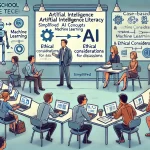
Top 10 questions asked in AI
April 30, 2024How can we improve the performance of AI models?
Improving the performance of AI models involves several strategies aimed at enhancing their accuracy, efficiency, and generalizability. Some key approaches to improve AI model performance include:
- Data preprocessing: High-quality data preprocessing is essential for improving AI model performance. This includes data cleaning to remove noise and outliers, data normalization to scale features, and feature engineering to extract relevant information from raw data.
- Feature selection: Identifying and selecting the most relevant features can improve AI model performance by reducing the dimensionality of the data and focusing on the most informative features. Feature selection techniques include statistical tests, feature importance scores, and domain knowledge.
- Model selection: Choosing the right model architecture and algorithm is crucial for improving AI model performance. This involves selecting models that are well-suited to the specific task and dataset, such as deep learning models for image and speech recognition, or tree-based models for tabular data.
- Hyperparameter tuning: Optimizing the hyperparameters of AI models can significantly improve their performance. Hyperparameters control the learning process of the model, such as the learning rate in gradient descent or the number of layers in a neural network. Hyperparameter tuning techniques include grid search, random search, and Bayesian optimization.
- Ensemble methods: Ensemble methods combine multiple AI models to improve performance. By aggregating the predictions of multiple models, ensemble methods can reduce variance and improve generalization. Common ensemble methods include bagging, boosting, and stacking.
- Transfer learning: Transfer learning involves using pre-trained models on similar tasks or datasets to improve performance on a new task or dataset. By leveraging knowledge from pre-trained models, transfer learning can reduce the amount of training data required and improve generalization.
- Data augmentation: Data augmentation techniques can improve AI model performance by artificially increasing the size of the training dataset. This can help prevent overfitting and improve the model’s ability to generalize to new data.
- Regularization: Regularization techniques, such as L1 and L2 regularization, can help prevent overfitting and improve AI model performance. Regularization penalizes complex models, encouraging them to learn simpler patterns that generalize better to new data.
By applying these strategies, researchers and practitioners can improve the performance of AI models and enhance their ability to solve complex tasks across a wide range of domains.
How can AI be applied to solve specific real-world problems?
AI can be applied to solve specific real-world problems across various domains by leveraging its ability to analyze large amounts of data, identify patterns, and make predictions or decisions. Some examples of how AI can be applied to solve specific real-world problems include:
- Healthcare: AI can be used to improve disease diagnosis and treatment planning by analyzing medical imaging data, electronic health records (EHRs), and genetic data. AI can also help in drug discovery and development by predicting drug interactions and side effects.
- Finance: AI can be used in finance for fraud detection, risk assessment, and algorithmic trading. AI algorithms can analyze financial transactions and market data to identify fraudulent activities and make real-time trading decisions.
- Retail: AI can be used in retail for personalized marketing, inventory management, and customer service. AI algorithms can analyze customer data to provide personalized recommendations and optimize inventory levels.
- Manufacturing: AI can be used in manufacturing for predictive maintenance, quality control, and process optimization. AI algorithms can analyze sensor data from manufacturing equipment to predict equipment failures and optimize production processes.
- Transportation: AI can be used in transportation for route optimization, traffic management, and autonomous vehicles. AI algorithms can analyze traffic data to optimize routes and reduce congestion, and enable autonomous vehicles to navigate safely.
- Education: AI can be used in education for personalized learning, student assessment, and administrative tasks. AI algorithms can analyze student data to provide personalized learning materials and feedback.
- Environmental monitoring: AI can be used in environmental monitoring for analyzing satellite imagery, weather data, and sensor data to monitor and predict environmental changes, such as deforestation, air pollution, and climate change.
These are just a few examples of how AI can be applied to solve specific real-world problems. The key to successfully applying AI is to understand the problem domain, gather relevant data, and develop AI algorithms that can effectively analyze the data and provide actionable insights or solutions.
How can AI systems be made more transparent and interpretable?
Making AI systems more transparent and interpretable is essential for building trust, ensuring accountability, and understanding how these systems make decisions. Several approaches can be used to achieve this goal:
- Explainable AI (XAI) techniques: XAI techniques aim to make AI models more interpretable by providing explanations for their decisions. This includes techniques such as feature importance scores, which highlight the most influential features in the model’s decision-making process, and model-agnostic approaches, which provide explanations that can be applied to any AI model.
- Simplifying model architectures: Using simpler model architectures, such as linear models or decision trees, can improve interpretability compared to complex models like deep neural networks. Simpler models are easier to understand and interpret, making them more transparent to users.
- Feature engineering: Carefully selecting and engineering features can improve the interpretability of AI models by focusing on the most relevant and interpretable features. This can help users understand how the model’s decisions are influenced by different input variables.
- Transparency in data and algorithms: Providing transparency in the data used to train AI models, as well as the algorithms themselves, can help users understand how decisions are made. This includes documenting data sources, preprocessing steps, and model training processes.
- Human-AI collaboration: Encouraging collaboration between AI systems and human experts can improve transparency and interpretability. By involving humans in the decision-making process, AI systems can provide explanations that align with human reasoning and understanding.
- Ethical considerations: Considering ethical principles, such as fairness, accountability, and transparency, in the design and deployment of AI systems can improve their transparency and interpretability. This includes ensuring that AI systems are fair and unbiased in their decision-making processes.
Overall, making AI systems more transparent and interpretable requires a combination of technical approaches, ethical considerations, and human-AI collaboration. By prioritizing transparency and interpretability in AI development, we can build more trustworthy and accountable AI systems that benefit society.
What are the ethical implications of AI?
The ethical implications of AI are wide-ranging and impact various aspects of society, including privacy, fairness, accountability, and autonomy. Some of the key ethical implications of AI include:
- Privacy: AI systems often rely on vast amounts of data, raising concerns about privacy and data protection. There are concerns about how AI systems collect, store, and use personal data, and the potential for these systems to infringe on individuals’ privacy rights.
- Fairness and bias: AI systems can exhibit biases, reflecting the biases present in the data used to train them or the design choices made by developers. This can lead to unfair outcomes, particularly in areas such as hiring, lending, and criminal justice, where AI systems are used to make decisions that impact people’s lives.
- Accountability: AI systems can make decisions autonomously, making it challenging to assign responsibility when things go wrong. There are concerns about the lack of transparency and accountability in AI systems, particularly in high-stakes applications such as healthcare and autonomous vehicles.
- Transparency and explainability: AI systems can be complex and opaque, making it difficult for users to understand how they make decisions. There are calls for AI systems to be more transparent and explainable, particularly in critical applications where human lives are at stake.
- Job displacement: AI and automation have the potential to disrupt labor markets, leading to job displacement and economic inequality. There are concerns about the impact of AI on employment, particularly for low-skilled workers.
- Autonomy and agency: AI systems can influence human decision-making and behavior, raising questions about autonomy and agency. There are concerns about the ethical implications of AI systems that can manipulate or influence human behavior.
- Security and safety: AI systems can be vulnerable to attacks and misuse, raising concerns about security and safety. There are concerns about the potential for AI systems to be hacked or manipulated for malicious purposes.
Addressing these ethical implications requires careful consideration and proactive measures to ensure that AI is developed and deployed in a way that benefits society while minimizing harm. This includes implementing ethical guidelines and standards, promoting transparency and accountability, and ensuring that AI is used in a fair and responsible manner.
How can AI be used to enhance human capabilities?
AI can be used to enhance human capabilities in various ways across different domains. Some key ways in which AI can enhance human capabilities include:
- Automation: AI can automate repetitive and mundane tasks, freeing up time for humans to focus on more creative and strategic tasks. This can increase productivity and efficiency in various industries.
- Augmented intelligence: AI can augment human intelligence by providing insights and recommendations based on analysis of large amounts of data. This can help humans make better decisions and solve complex problems.
- Personalization: AI can personalize products and services based on individual preferences and behaviors. This can enhance user experience and improve customer satisfaction.
- Healthcare: AI can improve healthcare outcomes by analyzing medical data to assist in disease diagnosis, treatment planning, and personalized medicine. AI can also help in remote monitoring of patients and predicting disease outbreaks.
- Education: AI can personalize learning experiences for students based on their learning styles and abilities. AI can also assist teachers in grading assignments, providing feedback, and developing customized learning materials.
- Creativity: AI can enhance human creativity by generating new ideas, designs, and artworks. AI-powered tools can assist artists, designers, and writers in their creative process.
- Accessibility: AI can improve accessibility for people with disabilities by providing assistive technologies such as speech recognition, natural language processing, and computer vision.
- Safety and security: AI can enhance safety and security by monitoring and analyzing data to detect and prevent accidents, crimes, and cybersecurity threats.
Overall, AI has the potential to enhance human capabilities in diverse ways, improving efficiency, decision-making, creativity, and accessibility across various domains.
How can we ensure the fairness and equity of AI systems?
Ensuring the fairness and equity of AI systems is crucial to mitigate bias and promote inclusivity. Several strategies can help achieve this goal:
- Diverse and representative data: Ensure that AI systems are trained on diverse and representative data sets to reduce bias. This includes considering factors such as race, gender, age, and socioeconomic status in the data collection process.
- Bias detection and mitigation: Use techniques to detect and mitigate bias in AI systems, such as fairness-aware machine learning algorithms, which can identify and address bias in training data and model predictions.
- Transparency and explainability: Make AI systems more transparent and explainable by providing clear explanations of how decisions are made. This can help users understand and trust AI systems, and identify and address any bias or unfairness.
- Human oversight: Incorporate human oversight into AI systems to ensure that decisions are fair and unbiased. This can include having humans review and interpret AI-generated decisions, especially in high-stakes applications.
- Regular audits and monitoring: Conduct regular audits and monitoring of AI systems to assess their fairness and equity. This can help identify and address any bias or unfairness that may arise over time.
- Diverse development teams: Include diverse perspectives in the development and deployment of AI systems. This can help identify and address biases that may be overlooked by homogeneous teams.
- Ethical guidelines and standards: Establish ethical guidelines and standards for the development and deployment of AI systems. This can help ensure that AI systems are designed and used in a fair and ethical manner.
- User education: Educate users about the potential biases and limitations of AI systems, and how to interpret and use AI-generated results in a fair and equitable manner.
By implementing these strategies, we can help ensure that AI systems are fair, unbiased, and equitable, and promote inclusivity and diversity in their development and use.
How can AI systems learn from limited or incomplete data?
AI systems can learn from limited or incomplete data using various techniques that help them generalize from the available data to make predictions or decisions. Some of the key approaches include:
- Data augmentation: Data augmentation techniques can artificially increase the size of the training dataset by creating variations of the existing data. This can help AI systems learn from limited data by providing additional examples to learn from.
- Transfer learning: Transfer learning involves leveraging knowledge from pre-trained models on related tasks or datasets to improve performance on a new task or dataset. This can help AI systems learn from limited data by transferring knowledge learned from a larger dataset.
- Semi-supervised learning: Semi-supervised learning combines labeled and unlabeled data to improve performance on a task. This can help AI systems learn from limited labeled data by using unlabeled data to generalize better.
- Active learning: Active learning involves selecting the most informative data points for labeling to improve the performance of the model. This can help AI systems learn from limited data by focusing on the most relevant examples.
- Generative models: Generative models, such as generative adversarial networks (GANs), can be used to generate synthetic data that can be used to augment the training dataset. This can help AI systems learn from limited data by providing additional training examples.
- Domain adaptation: Domain adaptation techniques can be used to adapt a model trained on one domain to perform well on a related but different domain. This can help AI systems learn from limited data in a new domain by leveraging knowledge from a related domain.
- Ensemble learning: Ensemble learning combines the predictions of multiple models to improve performance. This can help AI systems learn from limited data by combining the strengths of multiple models trained on different subsets of the data.
By using these techniques, AI systems can learn from limited or incomplete data and generalize well to new, unseen examples.
How can AI systems be made more robust and secure?
Making AI systems more robust and secure involves several strategies aimed at ensuring that they perform reliably and protect against vulnerabilities and attacks. Some key approaches to enhance the robustness and security of AI systems include:
- Adversarial training: Adversarial training involves training AI models on adversarial examples, which are carefully crafted inputs designed to deceive the model. This can help improve the robustness of AI systems against adversarial attacks.
- Robust data preprocessing: Robust data preprocessing techniques can help mitigate the impact of noisy or corrupted data on AI models. This includes techniques such as outlier detection and data normalization.
- Model ensembling: Ensembling multiple models can help improve the robustness of AI systems by reducing the impact of individual model vulnerabilities. This can help improve overall performance and resilience against attacks.
- Regular model retraining: Regularly retraining AI models on updated data can help maintain their performance and adapt to changing conditions. This can help improve the robustness of AI systems over time.
- Secure deployment: Secure deployment practices, such as using secure APIs and encryption, can help protect AI systems from attacks. This includes ensuring that data is encrypted both at rest and in transit, and that access to AI systems is restricted to authorized users.
- Adopting standards and best practices: Following industry standards and best practices for AI development and deployment can help ensure that AI systems are robust and secure. This includes adhering to principles such as privacy by design and data minimization.
- Continuous monitoring and auditing: Continuously monitoring and auditing AI systems can help detect and mitigate security vulnerabilities and performance issues. This includes monitoring for anomalous behavior and conducting regular security audits.
By implementing these strategies, AI systems can be made more robust and secure, protecting against vulnerabilities and ensuring reliable performance in various applications.
How can AI systems be designed to collaborate with humans effectively?
Designing AI systems to collaborate effectively with humans involves several key principles to ensure that the interaction between humans and AI is seamless, productive, and mutually beneficial. Some key approaches to designing AI systems for effective collaboration with humans include:
- User-centered design: Design AI systems with the needs and preferences of users in mind. This includes conducting user research to understand user requirements, preferences, and workflows, and incorporating user feedback throughout the design process.
- Natural language processing: Use natural language processing (NLP) techniques to enable AI systems to understand and generate human language. This can help facilitate natural and intuitive interactions between humans and AI.
- Explainability and transparency: Ensure that AI systems are transparent and explainable, providing users with clear explanations of how decisions are made. This can help build trust and confidence in AI systems and enable users to understand and validate AI-generated results.
- Context awareness: Design AI systems that are context-aware, able to adapt to different contexts and user preferences. This can help AI systems provide more relevant and personalized recommendations and assistance to users.
- Collaborative problem-solving: Enable AI systems to collaborate with humans in solving complex problems. This includes providing tools and interfaces that support collaborative decision-making and problem-solving processes.
- Human oversight: Incorporate human oversight into AI systems to ensure that humans can intervene and override AI decisions when necessary. This can help prevent AI systems from making incorrect or harmful decisions.
- Feedback mechanisms: Provide feedback mechanisms that enable users to provide input and corrections to AI systems. This can help improve the performance and accuracy of AI systems over time.
- Ethical considerations: Consider ethical principles such as fairness, accountability, and transparency in the design of AI systems. This includes ensuring that AI systems do not discriminate or harm users and that they respect user privacy and autonomy.
By incorporating these principles into the design of AI systems, designers can create AI systems that collaborate effectively with humans, enhancing productivity, decision-making, and overall user experience.
What are the long-term impacts of AI on society?
The long-term impacts of AI on society are wide-ranging and complex, with both positive and negative implications across various domains. Some of the key long-term impacts of AI on society include:
- Economic disruption: AI has the potential to disrupt labor markets and lead to job displacement, particularly for routine and repetitive tasks. This could lead to economic inequality and require new approaches to education and workforce development.
- Increased productivity: AI has the potential to increase productivity by automating tasks, improving efficiency, and enabling new forms of innovation. This could lead to economic growth and improved standards of living.
- Healthcare advances: AI has the potential to revolutionize healthcare by enabling personalized medicine, improving disease diagnosis and treatment, and enhancing the efficiency of healthcare delivery. This could lead to improved health outcomes and reduced healthcare costs.
- Ethical and societal implications: AI raises ethical and societal implications related to privacy, security, bias, and accountability. These issues will require careful consideration and regulation to ensure that AI is used responsibly and ethically.
- Environmental impact: AI has the potential to improve environmental monitoring, resource management, and sustainability efforts. This could help address environmental challenges such as climate change and pollution.
- Global competitiveness: AI is likely to impact global competitiveness, with countries and companies that lead in AI innovation gaining a competitive edge in various industries. This could lead to geopolitical shifts and changes in economic power dynamics.
- Human-machine collaboration: AI could change the nature of work and collaboration between humans and machines, leading to new forms of creativity, productivity, and innovation. This could reshape industries and professions, requiring new skills and ways of working.
- Education and workforce development: AI will require new approaches to education and workforce development to ensure that people are prepared for the jobs of the future. This could include emphasis on skills such as critical thinking, problem-solving, and adaptability.
Overall, the long-term impacts of AI on society will depend on how AI is developed, deployed, and regulated. By addressing ethical, social, and economic considerations, society can harness the potential of AI to improve lives and address global challenges.

















